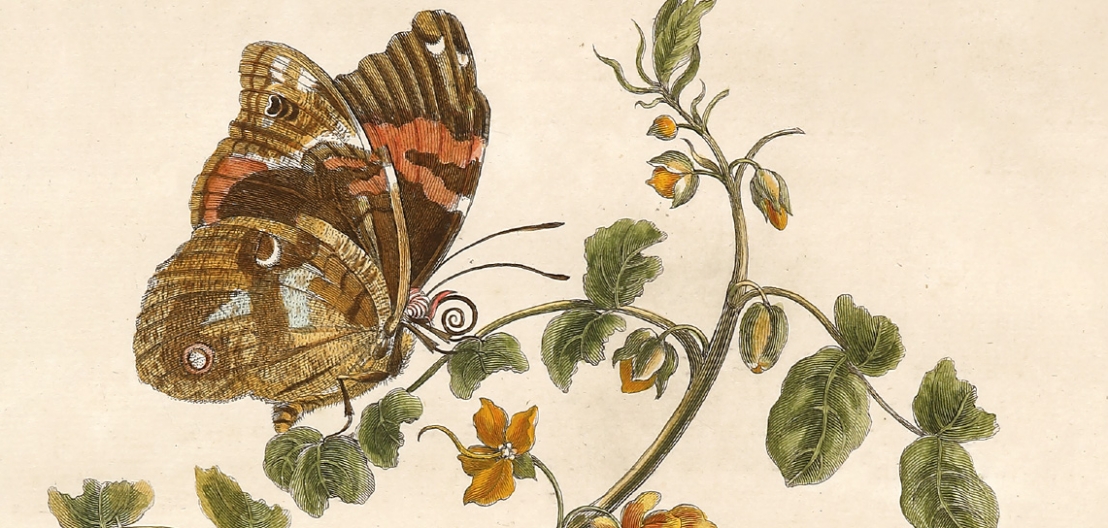From the collection of the Kunstkabinett Strehler
Maria Sibylla Merian died on 13 January 1717 in Amsterdam. The register of deaths describes her as a woman of meagre means. Forgotten for nearly two hundred years, she was rediscovered in the twentieth century, and in the twenty-first she is one of history’s most renowned female artists, an extraordinary, independent figure who defied her era’s ideas of women’s social roles, a prominent pioneering entomologist, traveller, entrepreneur, and publisher. Merian was active in a variety of fields but she went down in history primarily as the first entomologist to formulate, illustrate and document the appearance of living insects and their four-stage life cycle, from the egg, through the larva and pupa, to the adult imago, in addition to their feeding habits and overall functioning in the environment, and also as an artist creating suggestive, magical botanico-entomological illustrations.
In the twenty-first century, Maria Sibylla Merian’s art, research, and life fascinate not only entomologists, botanists, and art historians, but also, or perhaps above all, ordinary people who are not indifferent to nature, to flora and fauna. The large exhibitions of her work held in Europe and the United States, along with related catalogues and scientific sessions and seminars, discover ever new aspects of this seemingly well-known and easily-palatable art.
The Manggha Museum in Kraków is holding Poland’s first exhibition of the work of Maria Sibylla Merian, placing it in the context of modern-day botanical art, both European and Japanese, and also in the context of works by old masters of botanical illustration and artists creating ‘pictures of flowers and birds’ (Jap. kachō-ga), as part of the show
Exploring Botany. Botanical Art in the 21st Century.
The exhibition is also an extension of the museum’s programme of many years which focuses on, and often discovers, original aspects of the work of female artists, such as Olga Boznańska, Anna Bilińska, Aliska Lahusen, Gabriela Morawetz, Kyoko Kumai, Chiharu Shiota, or Tomoko Ishida.
The show comprises 69 works – copper engravings, in most cases handcoloured by the artist herself, including some counterproofs, extremely rare, and several black-and-white prints – from her major botanico-entomological publications,
Neues Blumenbuch (New book of flowers), the
Raupenbuch (The wondrous transformation of caterpillars…), and
Metamorphosis insectorum Surinamensium, from the collection of the Kunstkabinett Strehler. Here I would like to thank Birgit Strehler for her kindness and loaning the works to the exhibition.
While Maria Sibylla Merian’s interest in insects defied her era’s idea of social roles, which admitted botany into the domain of women’s occupations but would definitely rule out studying or being otherwise involved with ‘filthy vermin’, she was also definitely a woman of her time. Depicting Nature was a form of religious reflection to her, and her drawings were also meant to show the divine design of creation at the smallest scale. Saint Thérèse of the Child Jesus wrote: ‘You have heard how wonderfully silk is made – in a way such as God alone could plan – how it all comes from an egg resembling a tiny pepper-corn.’ In the same vein as the Carmelite mystic, Merian writes: ‘Thus do not seek to praise and honour me for this work, but rather God, glorifying him as the creator of even the smallest and most insignificant of these worms.’
While some of her observations and taxonomic attempts may no longer be valid today, the visual, artistic language of Merian’s depictions remains invariably masterly, suggestive, indeed magical.
The artist’s fascinating oeuvre seems more relevant in the twenty-first century than ever before as. The world of insects and plants that she captured in her work is facing extinction.
Anna Król, PhD
Curator




